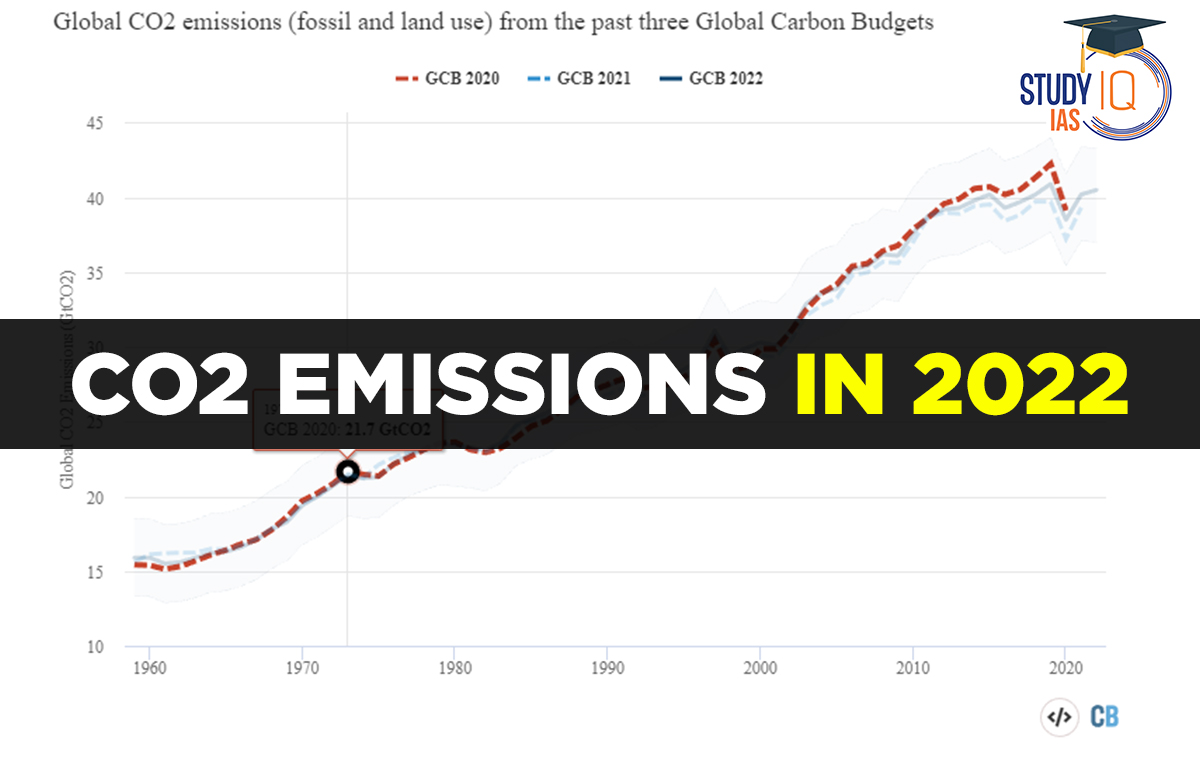Table of Contents
Context: According to the IEA’s ‘CO2 Emissions in 2022’ report, global energy-related carbon dioxide (CO2) emissions rose by under 1% in 2022.
About the ‘CO2 Emissions in 2022’ Report
- This report is the first in the IEA (International Energy Agency)’s new series, the Global Energy Transitions Stocktake.
- The report covers CO2 emissions from all energy combustion and industrial processes.
- It also includes information on methane and nitrous oxide emissions, providing a complete picture of energy-related greenhouse gas emissions in 2022.
Key Takeaways from the Report
Global Energy-Related CO2 Emissions
- New high: Global energy-related CO2 emissions grew by 0.9% or 321 Mt in 2022, reaching a new high of over 36.8 Gt.
- Composition: Of the 321 Mt CO2 increase, 60 Mt CO2 can be attributed to cooling and heating demand in extreme weather and another 55 Mt CO2 to nuclear power plants being offline.
- Lower than in 2021: The rise in CO2 emissions in 2022 was far smaller than the exceptional jump of over 6% in 2021.
- Despite energy price shocks, rising inflation and disruptions to traditional fuel trade flows, and gas-to-coal switching in many countries in 2022, global growth in emissions was lower than feared.
- Reasons behind better results in 2022:
- Increased deployment of clean energy technologies such as renewables, electric vehicles, and heat pumps helped prevent an additional 550 Mt in CO2 emissions.
- Industrial production curtailment, particularly in China and Europe, also averted additional emissions.
- Decoupling emissions from economic growth: CO2 growth in 2022 was well below global GDP growth of 3.2%, reverting to a decade-long trend of decoupling emissions and economic growth that was broken by 2021’s sharp rebound in emissions.
Global Energy-Related Greenhouse Gas Emissions
- New high: Total energy-related greenhouse gas emissions increased by 1.0% to an all-time high of 41.3 Gt CO2-eq in 2022.
- Composition:
- CO2 emissions from energy combustion and industrial process accounted for 89% of energy-related greenhouse gas emissions in 2022.
- Methane from energy combustion, leaks and venting represented another 10%, mostly coming from onshore oil and gas operations as well as steam coal production.

Fuel-by-fuel Analysis
- CO2 emissions from coal grew by 1.6% as the global energy crisis continued to spur a wave of gas-to-coal switching in Asia.
- The increase in coal emissions balanced the 1.6% decline in emissions from natural gas as supplies were limited by Russia’s invasion of Ukraine.
- CO2 emissions from oil grew by 2.5% (came mainly from the aviation sector) but still remained below pre-pandemic levels.
Region-by-Region Analysis
- China’s emissions were broadly flat in 2022 due to strict Covid-19 measures.
- The EU emissions fell by 2.5%, thanks to the record deployment of renewables and energy savings measures in response to Russia’s invasion of Ukraine also contributed.
- In the US, emissions grew by 0.8% as buildings increased their energy consumption to cope with extreme temperatures.
- Excluding China, emissions from Asia’s emerging and developing economies increased by 4.2%, reflecting their rapid economic and energy demand growth.
About the International Energy Agency
- It is a Paris-based autonomous intergovernmental organization which works with countries around the world to shape energy policies for a secure and sustainable future.
- Establishment: It was established in the wake of the oil crisis of 1973-1974, to help its members respond to major disruptions in oil supply.
- Objective: It mainly focuses on its energy policies which include economic development, energy security and environmental protection. These policies are also known as the 3 E’s of IEA.
- Important reports: World Energy Outlook Report, World Energy Investment Report, World Energy Statistics and India Energy Outlook Report.


 How African Reserves Eliminated Rhino Po...
How African Reserves Eliminated Rhino Po...
 Why India Needs Its Own Economic Model?
Why India Needs Its Own Economic Model?
 Challenges in India’s Airline Sector: ...
Challenges in India’s Airline Sector: ...

























